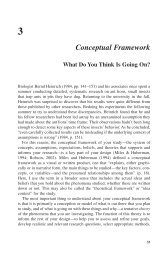Mixed Integer Linear Programming in Process Scheduling: Modeling ...
Mixed Integer Linear Programming in Process Scheduling: Modeling ...
Mixed Integer Linear Programming in Process Scheduling: Modeling ...
Create successful ePaper yourself
Turn your PDF publications into a flip-book with our unique Google optimized e-Paper software.
132 FLOUDAS AND LIN<br />
s<strong>in</strong>gle-unit multiproduct processes to the most general multipurpose processes. These<br />
process schedul<strong>in</strong>g problems are <strong>in</strong>herently comb<strong>in</strong>atorial <strong>in</strong> nature because of the many<br />
discrete decisions <strong>in</strong>volved, such as equipment assignment and task allocation over time.<br />
They belong to the set of NP-complete problems (Garey and Johnson, 1979), which<br />
means that the solution time scales exponentially as the problem size <strong>in</strong>creases <strong>in</strong> the<br />
worst case. This has important implications for the solution of schedul<strong>in</strong>g problems.<br />
There has been a number of reviews related to process schedul<strong>in</strong>g <strong>in</strong> the chemical<br />
eng<strong>in</strong>eer<strong>in</strong>g and the operations research literature. Reklaitis (1992) reviewed the<br />
schedul<strong>in</strong>g and plann<strong>in</strong>g of batch process operations, focus<strong>in</strong>g on the basic components<br />
of chemical process schedul<strong>in</strong>g problems and the available solution methods. Ripp<strong>in</strong><br />
(1993) summarized the development of batch process systems eng<strong>in</strong>eer<strong>in</strong>g with particular<br />
reference to the areas of design, plann<strong>in</strong>g, schedul<strong>in</strong>g and uncerta<strong>in</strong>ty. Grossmann et al.<br />
(1996) provided an overview of mixed-<strong>in</strong>teger optimization techniques for the design and<br />
schedul<strong>in</strong>g of batch chemical processes. They concentrated on basic solution methods<br />
and recent developments for mixed-<strong>in</strong>teger l<strong>in</strong>ear and nonl<strong>in</strong>ear programm<strong>in</strong>g problems<br />
and also discussed issues <strong>in</strong> model<strong>in</strong>g and reformulation. Bassett et al. (1996a) reviewed<br />
exist<strong>in</strong>g strategies for implement<strong>in</strong>g <strong>in</strong>tegrated applications based on mathematical programm<strong>in</strong>g<br />
models and exam<strong>in</strong>ed four classes of <strong>in</strong>tegration <strong>in</strong>clud<strong>in</strong>g schedul<strong>in</strong>g, control,<br />
plann<strong>in</strong>g and schedul<strong>in</strong>g across s<strong>in</strong>gle and multiple sites, and design under uncerta<strong>in</strong>ty.<br />
Applequist et al. (1997) discussed the formulation and solution of process schedul<strong>in</strong>g and<br />
plann<strong>in</strong>g problems, as well as issues associated with the development and use of schedul<strong>in</strong>g<br />
software. Shah (1998) exam<strong>in</strong>ed first different techniques for optimiz<strong>in</strong>g production<br />
schedules at <strong>in</strong>dividual sites, with an emphasis on formal mathematical methods, and<br />
then focused on progress <strong>in</strong> the overall plann<strong>in</strong>g of production and distribution <strong>in</strong> multisite<br />
flexible manufactur<strong>in</strong>g systems. Pekny and Reklaitis (1998) discussed the nature<br />
and characteristics of the schedul<strong>in</strong>g/plann<strong>in</strong>g problems and po<strong>in</strong>ted out the key implications<br />
for the solution methodology for these problems. They reviewed the available<br />
schedul<strong>in</strong>g technologies, <strong>in</strong>clud<strong>in</strong>g randomized search, rule-based methods, constra<strong>in</strong>t<br />
guided search, simulation-based strategies, as well as mathematical programm<strong>in</strong>g formulation<br />
based approaches us<strong>in</strong>g conventional and eng<strong>in</strong>eered solution algorithms. P<strong>in</strong>to<br />
and Grossmann (1998) presented an overview of assignment and sequenc<strong>in</strong>g models used<br />
<strong>in</strong> process schedul<strong>in</strong>g with mathematical programm<strong>in</strong>g techniques. They identified two<br />
major categories of schedul<strong>in</strong>g models—one for s<strong>in</strong>gle-unit assignment and the other for<br />
multiple-unit assignment—and discussed the critical issues of time representation and<br />
network structure.<br />
Given the computational complexity of comb<strong>in</strong>atorial problems aris<strong>in</strong>g from process<br />
schedul<strong>in</strong>g, it is of crucial importance to develop effective mathematical formulations<br />
to model the manufactur<strong>in</strong>g processes and to explore efficient solution approaches<br />
for such problems. The objective of this paper is to present an overview of advances <strong>in</strong><br />
MILP based approaches for process schedul<strong>in</strong>g problems. We focus on the short-term<br />
schedul<strong>in</strong>g of general network represented processes. The rest of this paper is organized<br />
as follows. First, the mathematical models that have been proposed <strong>in</strong> the literature are<br />
classified and presented along with their strengths and limitations. Then, a variety of
















